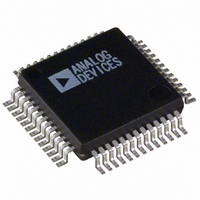ADUC824BSZ Analog Devices Inc, ADUC824BSZ Datasheet - Page 59

ADUC824BSZ
Manufacturer Part Number
ADUC824BSZ
Description
IC,Data Acquisition CODEC,2-CHANNEL,QFP,52PIN,PLASTIC
Manufacturer
Analog Devices Inc
Series
MicroConverter® ADuC8xxr
Specifications of ADUC824BSZ
Core Processor
8052
Core Size
8-Bit
Speed
12.58MHz
Connectivity
EBI/EMI, I²C, SPI, UART/USART
Peripherals
POR, PSM, Temp Sensor, WDT
Number Of I /o
34
Program Memory Size
8KB (8K x 8)
Program Memory Type
FLASH
Eeprom Size
640 x 8
Ram Size
256 x 8
Voltage - Supply (vcc/vdd)
2.7 V ~ 5.25 V
Data Converters
A/D 3x16b, 4x24b; D/A 1x12b
Oscillator Type
Internal
Operating Temperature
-40°C ~ 85°C
Package / Case
52-MQFP, 52-PQFP
Cpu Family
ADuC8xx
Device Core
8052
Device Core Size
8b
Frequency (max)
12.58MHz
Interface Type
I2C/SPI/UART
Total Internal Ram Size
256Byte
# I/os (max)
26
Number Of Timers - General Purpose
3
Operating Supply Voltage (typ)
3.3/5V
Operating Supply Voltage (max)
5.25V
Operating Supply Voltage (min)
2.7V
On-chip Adc
2(2-chx24-bit)
On-chip Dac
1-chx12-bit
Instruction Set Architecture
CISC
Operating Temp Range
-40C to 85C
Operating Temperature Classification
Industrial
Mounting
Surface Mount
Pin Count
52
Package Type
MQFP
Lead Free Status / RoHS Status
Lead free / RoHS Compliant
Lead Free Status / RoHS Status
Lead free / RoHS Compliant, Lead free / RoHS Compliant
Available stocks
Company
Part Number
Manufacturer
Quantity
Price
Company:
Part Number:
ADUC824BSZ
Manufacturer:
INTEL
Quantity:
19
Company:
Part Number:
ADUC824BSZ
Manufacturer:
ADI
Quantity:
329
Company:
Part Number:
ADUC824BSZ
Manufacturer:
Analog Devices Inc
Quantity:
10 000
Part Number:
ADUC824BSZ
Manufacturer:
ADI/亚德诺
Quantity:
20 000
Company:
Part Number:
ADUC824BSZ-REEL
Manufacturer:
Analog Devices Inc
Quantity:
10 000
Timer 1 Generated Baud Rates
When Timer 1 is used as the baud rate generator, the baud rates
in Modes 1 and 3 are determined by the Timer 1 overflow rate and
the value of SMOD as follows:
Modes 1 and 3 Baud Rate = (2
The Timer 1 interrupt should be disabled in this application. The
Timer itself can be configured for either timer or counter opera-
tion, and in any of its three running modes. In the most typical
application, it is configured for timer operation, in the autoreload
mode (high nibble of TMOD = 0100Binary). In that case, the baud
rate is given by the formula:
Modes 1 and 3 Baud Rate =
A very low baud rate can also be achieved with Timer 1 by leaving
the Timer 1 interrupt enabled, and configuring the timer to run
as a 16-bit timer (high nibble of TMOD = 0100Binary), and using
the Timer 1 interrupt to do a 16-bit software reload. Table XXVIII
below, shows some commonly-used baud rates and how they
might be calculated from a core clock frequency of 1.5728 MHz
and 12.58 MHz. Generally speaking, a 5% error is tolerable
using asynchronous (start/stop) communications.
Ideal
Baud
9600
2400
1200
1200
(2
SMOD
Table XXVIII. Commonly Used Baud Rates, Timer 1
/32) × (Core Clock/(12 × [256-TH1]))
Core
CLK
12.58
12.58
12.58
1.57
NOTE: OSC. FREQ. IS DIVIDED BY 2, NOT 12.
NOTE AVAILABILITY OF ADDITIONAL
EXTERNAL INTERRUPT
THE CORE CLOCK IS THE OUTPUT OF THE PLL AS DESCRIBED ON PAGE 42.
TRANSITION
SMOD
Value
1
1
1
1
T2EX
DETECTOR
PIN
PIN
CORE
CLK
T2
TH1-Reload
Value
–7 (F9h)
–27 (E5h)
–55 (C9h)
–7 (F9h)
SMOD
2
/32) × (Timer 1 Overflow Rate)
C/T2 = 0
C/T2 = 1
EXEN2
CONTROL
CONTROL
Actual
9362
2427
1192
1170
Baud
TR2
EXF
2
%
Error
2.5
1.1
0.7
2.5
RCAP2L
(8-BITS)
TL2
TIMER 2
INTERRUPT
RCAP2H
(8-BITS)
Timer 2 Generated Baud Rates
Baud rates can also be generated using Timer 2. Using Timer 2 is
similar to using Timer 1 in that the timer must overflow 16 times
before a bit is transmitted/received. Because Timer 2 has a 16-bit
autoreload mode a wider range of baud rates is possible using
Timer 2.
Modes 1 and 3 Baud Rate = (1/16) × (Timer 2 Overflow Rate)
Therefore, when Timer 2 is used to generate baud rates, the timer
increments every two clock cycles and not every core machine cycle
as before. Hence, it increments six times faster than Timer 1, and
therefore baud rates six times faster are possible. Because Timer 2
has 16-bit autoreload capability, very low baud rates are still possible.
Timer 2 is selected as the baud rate generator by setting the TCLK
and/or RCLK in T2CON. The baud rates for transmit and receive
can be simultaneously different. Setting RCLK and/or TCLK puts
Timer 2 into its baud rate generator mode as shown in Figure 42.
In this case, the baud rate is given by the formula:
Modes 1 and 3 Baud Rate
Table XXIX shows some commonly used baud rates and how they
might be calculated from a core clock frequency of 1.5728 MHz
and 12.5829 MHz.
Ideal
Baud
19200
9600
2400
1200
9600
2400
1200
TH2
= (Core Clk)/(32 × [65536 – (RCAP2H, RCAP2L)])
Table XXIX. Commonly Used Baud Rates, Timer 2
RELOAD
OVERFLOW
Core
CLK
12.58
12.58
12.58
12.58
1.57
1.57
1.57
TIMER 2
RCAP2H
Value
–1 (FFh)
–1 (FFh)
–1 (FFh)
–2 (FEh)
–1 (FFh)
–1 (FFh)
–1 (FFh)
1
1
OVERFLOW
2
0
TIMER 1
0
0
1
RCAP2L
Value
–20 (ECh)
–41 (D7h)
–164 (5Ch) 2398
–72 (B8h)
–5 (FBh)
–20 (ECh)
–41 (D7h)
TCLK
RCLK
16
16
SMOD
RX
CLOCK
TX
CLOCK
ADuC824
Actual
19661
9591
1199
9830
2458
1199
Baud
%
Error
2.4
0.1
0.1
0.1
2.4
2.4
0.1



















